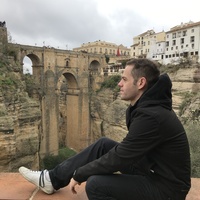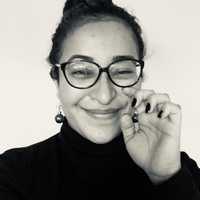Books by Borja Franco Llopis
díaz del campo borja franco llopis (eds.
https://gup.unige.it/a-mediterranean-other

Alzira va ser una de les poblacions més destacades del període musulmà, amb fills
il·lustres com ... more Alzira va ser una de les poblacions més destacades del període musulmà, amb fills
il·lustres com ara els cèlebres escriptors Ibn Amira, Ibn Hafaja, Ibn Tomlus o Iban
Al-Zaqaq. Va ser l’escenari del martiri de tres germans que, amb el temps, esdevingueren
els seus patrons així com l’escenari de la mort del seu rei conqueridor. També
en l’etapa medieval, arran de la conquesta de Jaume I, vam ser una de les principals
viles del regne de València, juntament amb la capital i Xàtiva, Oriola i Morella. És la
pàtria del cardenal Jaume Serra que quasi arribà a ser papa a les primeries del segle
DIRECTORS
DE LA HISTÒRIA D’ALZIRA
PRESENTACIÓ
DIRECTORS
DE LA HISTÒRIA D’ALZIRA
Ester Alba Pagan
Degana de la Facultat de Geografia i Història
Aureliano J. Lairón Plá
Arxiver municipal i Cronista oficial d’Alzira
XVI. Pot presumir orgullosa de ser la pàtria i llotja de la taronja i del seu comerç, amb
algun altre camp de tarongers documentat ja en el segle XV. Va ser la ciutat que es
va prestar al savi bacteriòleg Jaume Ferran per a la pràctica de la vacuna anticolèrica
que tants i bons resultats va donar. Va ser la ciutat on Emilio Castelar, president de la
I República Espanyola, intentà el regeneracionisme republicà, una ciutat progressista
on es va desenvolupar fortament el sindicalisme, l’associacionisme obrer i agrari i on
es va fundar la segona Casa del Poble d’Espanya, va ser la ciutat que va inspirar el
novel·lista Blasco Ibáñez per a escriure una de les seues més inspirades obres literaries:
Entre naranjos, una ciutat que entre finals del segle XIX i fins als anys seixanta
del segle passat va ser pel seu nombre d’habitants la primera de la província, la ciutat
natal d’un dels més grans empresaris que ha tingut l’Estat espanyol, l’industrial Lluís
Suñer, etc.
Se trata de una traducción al italiano, edición y ampliación de algunos aspectos de la parte artí... more Se trata de una traducción al italiano, edición y ampliación de algunos aspectos de la parte artística del libro: Pintando al converso: La imagen del morisco en la península ibérica (1492-1614). Se han reorganizado distintos temas vinculados con la representación de los cristianos nuevos de moros en la cultura visual hispánica durante la edad moderna. Cuenta con un prólogo de Bruno Pomara sobre los moriscos en Italia, para contextualizar esta publicación.
https://brill.com/view/title/54033
Editorial Universitaria Ramón Areces, 2018
El concepto de identidad es uno de los más debatidos en las ciencias sociales. La coexistencia de... more El concepto de identidad es uno de los más debatidos en las ciencias sociales. La coexistencia de judíos, cristianos y musulmanes en el Mediterráneo, durante los periodos medieval y moderno, es un perfecto marco geográfico y cronológico para cuestionar la utilidad de dicho concepto. A través de las aportaciones de diversos investigadores europeos, este volumen plantea una poliédrica revisión del mismo a través de la historia, historia del arte y de la literatura. ¿Qué papel tuvo la religión y la política en la reafirmación de las distintas identidades de los pueblos que convivieron en torno al Mediterráneo? ¿Qué mitos han marcado el estudio de la alteridad religiosa? ¿Qué papel jugó el arte como catalizador y visualizador de dichos conflictos? Son algunas preguntas que están en el génesis del presente libro y que tratan de ser respondidas.

From the mid 16th century to the beginning of the 17th century, there was an undoubtedly agitated... more From the mid 16th century to the beginning of the 17th century, there was an undoubtedly agitated period of social, political, financial and religious matters. Many slight ecclesiastic reformations were carried out in the Spanish territory, ahead of the Council of Trent (1545-1563), and parallel to -if not ahead of- Lutheran attacks. Art was an essential tool in indoctrinating and an excellent example of such instability. Adding to this was the endogenous factor to the diocese of Valencia: the problem of Moriscos. Different measures were applied to educate them and avoid final expulsion -which actually happened in 1609-. There were never enough measured to achieve the real conversion of Muslims. Art played once again an essential role in this framework. In this work, the diverse school schools of thought influencing art development in them late 16th and early 17th centuries will be analysed. It is in fact a social outlook of art in Valencia in the Modern period.
Papers by Borja Franco Llopis
De Arte, 2024
Las obras de los Hernandos en general, y las de Fernando Yánez de Almedina en particular, han sid... more Las obras de los Hernandos en general, y las de Fernando Yánez de Almedina en particular, han sido analizadas desde múltiples puntos de vista, pero aún queda pendiente un estudio de sus dibujos subyacentes. El objetivo de este artículo es mostrar que el estudio detallado de estos dibujos puede ser clave para entender el proceso creativo del artista conquense. Al someter las cuatro tablas conservadas en el Museu de Belles Arts de València a la fotografía infrarroja, ha sido posible identificar algunas técnicas que satisfacían las necesidades formales y expresivas de los artistas. También muestran una cierta versatilidad hasta ahora no detectada en la transposición de la idea preliminar a la pintura final, lo que contribuye a comprender la identidad artística de este pintor.
The aim of this paper is to reflect about the uses of Islamic-inspired textiles in the production... more The aim of this paper is to reflect about the uses of Islamic-inspired textiles in the production of the painter Joan de Borgonya through one of his most relevant altarpieces. We analyze the model that he followed, and we insert it in the Hispanic context, in which these textiles were usually represented as an image of magnificence and wealth. At the same time, his production is analyzed in comparison with that of other Hispanic artists who, like Borgonya, took Andalusí and Ottoman manufactures as a source of inspiration and used them as a language of power, in order to illustrate how the use of these textiles in painting is a constant in Hispanic visual culture from the late Middle Ages to the Early Modern Era.

The focus of the present paper is a prescient political allegory that was used to represent the I... more The focus of the present paper is a prescient political allegory that was used to represent the Iberian monarchs' fight against Islam: the Battle of the Giants. We explore the propagandistic significance of this allegory through an analysis of its two principal forms: the Gigantomachy and the Titanomachy. Taking the Gigantomachies created by Giulio Romano and Perino del Vaga as our point of departure, this study develops a diachronic approach to reconstructing the genesis, evolution and dissemination of this mythological theme in Italy and the Iberian Peninsula from the early sixteenth to the early eighteenth centuries. Attention is then turned to the incorporation of this allegory into the political discourse of the Hispanic Monarchy from the end of the sixteenth century onwards. Careful scrutiny is paid to invocations of this allegory in the ephemeral decorations created for royal festivals during the early modern period, and it is asked: who gained political capital from these events?











Uploads
Books by Borja Franco Llopis
il·lustres com ara els cèlebres escriptors Ibn Amira, Ibn Hafaja, Ibn Tomlus o Iban
Al-Zaqaq. Va ser l’escenari del martiri de tres germans que, amb el temps, esdevingueren
els seus patrons així com l’escenari de la mort del seu rei conqueridor. També
en l’etapa medieval, arran de la conquesta de Jaume I, vam ser una de les principals
viles del regne de València, juntament amb la capital i Xàtiva, Oriola i Morella. És la
pàtria del cardenal Jaume Serra que quasi arribà a ser papa a les primeries del segle
DIRECTORS
DE LA HISTÒRIA D’ALZIRA
PRESENTACIÓ
DIRECTORS
DE LA HISTÒRIA D’ALZIRA
Ester Alba Pagan
Degana de la Facultat de Geografia i Història
Aureliano J. Lairón Plá
Arxiver municipal i Cronista oficial d’Alzira
XVI. Pot presumir orgullosa de ser la pàtria i llotja de la taronja i del seu comerç, amb
algun altre camp de tarongers documentat ja en el segle XV. Va ser la ciutat que es
va prestar al savi bacteriòleg Jaume Ferran per a la pràctica de la vacuna anticolèrica
que tants i bons resultats va donar. Va ser la ciutat on Emilio Castelar, president de la
I República Espanyola, intentà el regeneracionisme republicà, una ciutat progressista
on es va desenvolupar fortament el sindicalisme, l’associacionisme obrer i agrari i on
es va fundar la segona Casa del Poble d’Espanya, va ser la ciutat que va inspirar el
novel·lista Blasco Ibáñez per a escriure una de les seues més inspirades obres literaries:
Entre naranjos, una ciutat que entre finals del segle XIX i fins als anys seixanta
del segle passat va ser pel seu nombre d’habitants la primera de la província, la ciutat
natal d’un dels més grans empresaris que ha tingut l’Estat espanyol, l’industrial Lluís
Suñer, etc.
Papers by Borja Franco Llopis
il·lustres com ara els cèlebres escriptors Ibn Amira, Ibn Hafaja, Ibn Tomlus o Iban
Al-Zaqaq. Va ser l’escenari del martiri de tres germans que, amb el temps, esdevingueren
els seus patrons així com l’escenari de la mort del seu rei conqueridor. També
en l’etapa medieval, arran de la conquesta de Jaume I, vam ser una de les principals
viles del regne de València, juntament amb la capital i Xàtiva, Oriola i Morella. És la
pàtria del cardenal Jaume Serra que quasi arribà a ser papa a les primeries del segle
DIRECTORS
DE LA HISTÒRIA D’ALZIRA
PRESENTACIÓ
DIRECTORS
DE LA HISTÒRIA D’ALZIRA
Ester Alba Pagan
Degana de la Facultat de Geografia i Història
Aureliano J. Lairón Plá
Arxiver municipal i Cronista oficial d’Alzira
XVI. Pot presumir orgullosa de ser la pàtria i llotja de la taronja i del seu comerç, amb
algun altre camp de tarongers documentat ja en el segle XV. Va ser la ciutat que es
va prestar al savi bacteriòleg Jaume Ferran per a la pràctica de la vacuna anticolèrica
que tants i bons resultats va donar. Va ser la ciutat on Emilio Castelar, president de la
I República Espanyola, intentà el regeneracionisme republicà, una ciutat progressista
on es va desenvolupar fortament el sindicalisme, l’associacionisme obrer i agrari i on
es va fundar la segona Casa del Poble d’Espanya, va ser la ciutat que va inspirar el
novel·lista Blasco Ibáñez per a escriure una de les seues més inspirades obres literaries:
Entre naranjos, una ciutat que entre finals del segle XIX i fins als anys seixanta
del segle passat va ser pel seu nombre d’habitants la primera de la província, la ciutat
natal d’un dels més grans empresaris que ha tingut l’Estat espanyol, l’industrial Lluís
Suñer, etc.
Traditionally, when dealing with the study of urban celebrations in the Middle and Early Modern periods, historiography has accepted the concept of Gesamtkunstwerk to point out the magnificence and diversity of artistic expressions that were part of these ephemeral events. Without totally opposing this idea, reinforced by methodological currents such as the history of emotions, this paper aims to reflect on the concept of urban celebrations. We will provide new perspectives in the study of these performances, especially their short-lived nature, which prevented the people from having access to all the acts and messages that involved these events. To this end, we propose a new approach to documentary and literary sources, from the point of view of the analysis of the Muslim other. We study its visual representation as well as its role as a spectator and active participant, especially as a dancer or musician. This allows us to present a new methodological framework using Valencia as a case study.
https://www.brepols.net/products/IS-9782503598673-1
Fundación BBVA. Palacio del Marqués de Salamanca. Paseo de Recoletos 10, Madrid, 18 y 19 de Mayo de 2017
an unpublished, high quality painting: a magnificent representation of San Pascual Bailon. We demonstrate the
technical-artristic relationship of this canvas with the Valencian Baroque and emphasize those aspects of his work
which resulted in his paintings being appreciated during the period
Barcelona : Universitat Oberta de Catalunya, 2016
Título: Libros sobre los moriscos.
Conferenciantes:
Dr. Seth Kimmel (Universidad de Columbia, USA).
Dr. Mayte Green-Mercado (Universidad de Rutgers, USA).
Dr. Borja Franco Llopis (Universidad Nacional de Educación a Distancia, España).
Dr. Mònica Colominas Aparicio (Universidad de Groninga, Países Bajos).
Dr. Mohamed Saadan Saadan (Universidad Mohammed V, Marruecos).
Fecha: 22 de junio de 2021, a las 17:00 en Túnez (+01 GMT)
Esta serie de seminarios en línea titulados: “Moriscos sin fronteras” tienen como objetivo estudiar la cuestión morisca desde diferentes puntos de vista, a través los diversos temas que vamos a tratar, o los investigadores que van a presentar sus trabajos, especialistas – como se refiere el título de nuestro seminario- son de todo el mundo, y tienen varias especialidades y aproximaciones.
Organizador: Laboratoire Régions et Ressources patrimoniales de Tunisie-LR99ES23 (Universidad de la Manouba)
Coordinador: Dr. Houssem Eddine Chachia
NB: La charla va a ser en español, pero las cuestiones se pueden ser en inglés, francés o árabe.
Enlace de registro: https://us02web.zoom.us/meeting/register/tZUoc-Gqpj4pHtJId1U0wrvxx8o6CeaOZ05D
Abstract: Over the past decades, there has been a growing interest among scholars in analysing the early modern migration routes and identity spaces in the Mediterranean. The Sephardic and Morisco diasporas are a typical example to study the forced movement of persons, but also of ideas and expertise. The aim of this training school is to discuss those issues from different and complementary perspectives, including social, cultural history, but also heritage and architecture, and to question the integrations of those religious and cultural minorities into Early Modern North African societies: the difficulties of their social assimilation, how their identities developed in this context, their contribution to the development of host societies, etc. Field visits and on-site discussions in Medina of Tunis and Testour will be complemented with conferences and debate sessions, focused on the students’ personal research. The overarching goal is to create a space of debate and exchange among junior and senior scholars, as well as to promote a network of scholars of early modern migration and identities that will bring new perspectives into the field. Students will be asked to prepare one small introduction to a specific monument that will be discussed on those visits, and to make a brief presentation of their own case studies, with a specific focus on problems of research and methodologies, in one of the three panels specified below. The training school is part of the COST-Action “Islamic Legacy: East, West, North South of the Mediterranean (1350-1750)”.
Deadline and details: Students interested to participate in this training school are invited to submit their cover letters and CVs to Dr. Houssem Eddine Chachia (h.chachia@fshst.rnu.tn), Dr. Elena Paulino Montero (epaulino@geo.uned.es) and Dr. Emir O. Filipović (filipovic@europe.com) before 15th April 2022. In addition to the specific standards established by COST Association regarding COVID-19 pandemic, participants in the Training School must also consider the measures adopted by local or national authorities in Tunis.